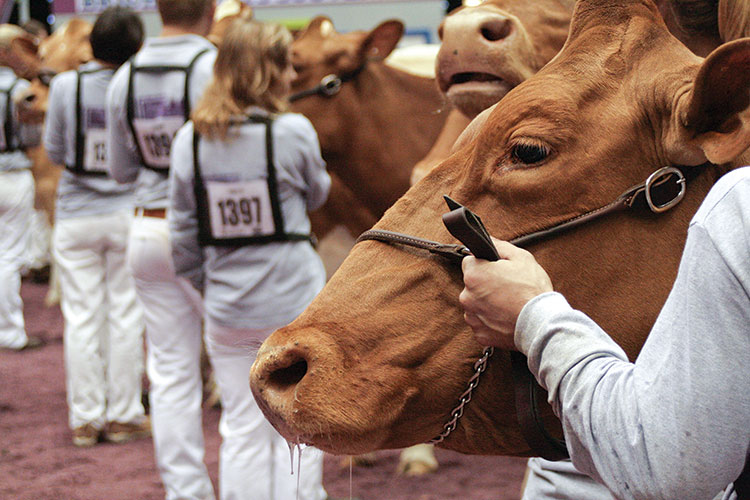
The scorecard was previously revised in 2003. “The 2003 version of the scorecard used a concept similar to the PDCA Dairy Cattle Evaluation Unified Scorecard; there were major categories and points allocated to each category,” noted Ted Halbach, former extension youth specialist and now director of the University of Wisconsin’s Farm and Industry Short Course.
These major categories were: appearance of animal — 30 points, appearance of exhibitor — 10 points, and showing in the ring — 60 points. Within each of these major groupings, there were subcategories that broke down how points were to be allocated. In reality, though, showmanship judges were not evaluating this way, and there was little consistency from judge to judge during showmanship contests.
The PDCA’s scorecard revision committee set out to determine the correct way to judge showmanship participants and then translate that into education programs. To do this, they looked to the model developed by Holstein Canada.
The committee, chaired by Ted Halbach, consisted of members with a wealth of showing, judging, and extension experience. Stan Henderson, Cal Poly; Bonnie Ayars, Ohio State; and Katharine Knowlton, Virginia Tech, were the U.S. contingent. Bert Stewart, a showman with an unparalleled background in the ring, was the Holstein Canada representative. Stewart also served on Holstein Canada’s committee when it developed its showmanship resources.
Rounding out the group was Jason French, with the Ontario branch of Holstein Canada. French was key when working on the logistics of Holstein Canada allowing the PDCA to use the resources it had developed in 1998. Holstein Canada made another investment and revised these resources again in 2011.
“For years, Canada had followed a different track,” said Halbach. “It had a more comprehensive program that coordinated its available educational materials and the judging of showmanship.” Canada’s methodology focused on how judges actually evaluated participants.
Holstein Canada invested heavily in its “Leading to Win” book and DVD to teach youth how to perform in showmanship. “By far, Holstein Canada had the best learning tools for showmanship,” noted Halbach. The problem with teaching youth from these materials, though, was that they were then judged based on the PDCA scorecard. “Participants were confused; they learned one way and then had to return to the U.S. scorecard.”
In line with how we think
“As judges evaluate participants in the contest, their philosophy is to use a process of elimination. They see a showman come into the ring and make observations about the animal (is the heifer dirty or not clipped evenly?) and the skill level of the participant,” noted Halbach. “It is the natural way, the right way for someone to judge,” he added.
“In addition to the lack of uniformity among judges on how to evaluate, there was no single educational product in the U.S. that was able to convey what youth were being taught about showmanship,” said Halbach. “When we would show the ‘Leading to Win’ DVD to judges at state fairs and other competitions, we had to include a disclaimer. They would see the DVD, but this isn’t how the scorecard is set up here.”
Halbach, too, used the “Leading to Win” materials with students, but there was always a disconnect between what they were learning and how they were evaluated in the ring.
PDCA recognized that Holstein Canada’s significant investment in two products, a showmanship book and DVD, had created a great educational resource. “Instead of recreating the wheel, our committee decided to utilize the resources that were available,” he added.
Initially, there was variation among the members on what should be done. After several meetings, a suitable draft scorecard that accounted for the levels of discrimination was developed and taken to PDCA meetings around the country for review. Here, they received feedback on whether the scorecard made sense, if the traits lined up correctly, or if anything was missing.
A uniform system
“For youth showmen and judges, there is now a comprehensive resource they can go to and know what is expected,” noted Halbach. Showmen are no longer being evaluated on something different than what they are being taught; there is uniformity from beginning to end.
“It is fun to be a good showman and have poise and confidence in the ring. Youth now have a visual resource where they can see how it is supposed to be done,” added Halbach.
Similar to the previous scorecard, there are three breakdowns. But, instead of categories with points equating to showmanship perfection, the scorecard categories are formulated on skills.
Previously, PDCA’s showmanship pamphlet had the levels of discrimination listed but not in an organized fashion. As an example, Halbach chose posing animal in the ring, under the category showing in the ring. “The first item reads, legs incorrectly posed (unbalanced, stretched, rear legs in wrong position): slight to serious discrimination; second, is animal posed downhill (front end too low): slight discrimination. The fourth item, positioning animals rear legs by stepping on rear feet or pasterns: serious discrimination.”
The committee agreed that the previous scorecard organization did not allow for a quick interpretation of how to classify an action regarding discrimination severity. “The new layout for the scorecard better follows how people think. As a judge, you can look at the levels and learn what actions fall into which category. It is organized in a way that is easily interpreted versus being all mixed up,” Halbach noted.
“This new breakdown will also enable judges to better communicate to youth why they placed in a certain spot and how they did in the contest.”
Despite the categorization based on discriminations, the committee does not intend for the scorecard to be negative. “When taken in context with the DVD and book, it is a chance to show participants how to show the right way,” noted Halbach. The larger potential is to show youth the right way to do things, the only time discriminations are brought in is in relation to the three categories.
“The scorecard changes take in account how we teach kids and have judges evaluating on the standards that are being taught,” concluded Halbach.
More in this showmanship series:
In March 10: Scorecard updates for 2012 show season
In April 10: How to succeed in showmanship
“Leading to Win,” contains an official copy of the newly released PDCA scorecard. It can be purchased from the Hoard’s Dairyman Bookstore, www.hoards.com/bookstore, or (920) 563-5551, for $5 in the U.S. An additional “Leading to Win” DVD can be purchased for $15 to view exhibitors demonstrating appropriate showmanship techniques.











